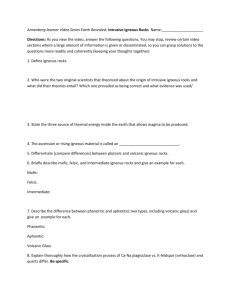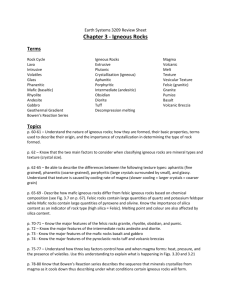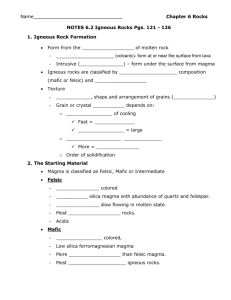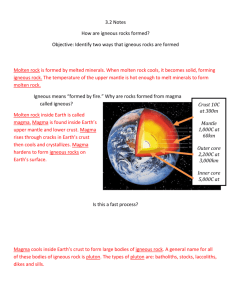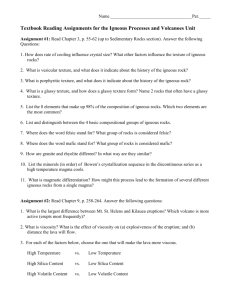userfiles/269/my files/geology ch 4 objectives?id=259
advertisement
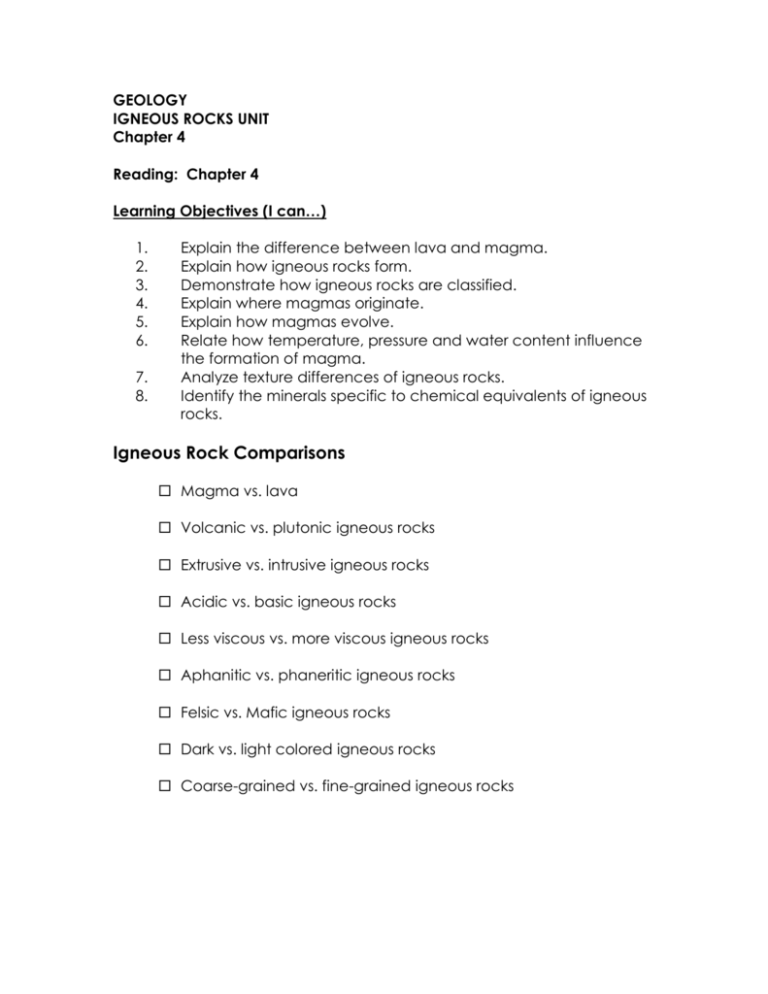
GEOLOGY IGNEOUS ROCKS UNIT Chapter 4 Reading: Chapter 4 Learning Objectives (I can…) 1. 2. 3. 4. 5. 6. 7. 8. Explain the difference between lava and magma. Explain how igneous rocks form. Demonstrate how igneous rocks are classified. Explain where magmas originate. Explain how magmas evolve. Relate how temperature, pressure and water content influence the formation of magma. Analyze texture differences of igneous rocks. Identify the minerals specific to chemical equivalents of igneous rocks. Igneous Rock Comparisons Magma vs. lava Volcanic vs. plutonic igneous rocks Extrusive vs. intrusive igneous rocks Acidic vs. basic igneous rocks Less viscous vs. more viscous igneous rocks Aphanitic vs. phaneritic igneous rocks Felsic vs. Mafic igneous rocks Dark vs. light colored igneous rocks Coarse-grained vs. fine-grained igneous rocks Key Terms Igneous Rocks Plutonic Granite Pegmatite Diorite Gabbro Peridotite Volcanic Rhyolite Andesite Basalt Komatiite Tuff Breccia ash obsidian pumice welded tuff scoria Descriptive Terms Aphanitic mafic Acidic Volcanic Vesicular Phaneritic ultra-mafic Basic Plutonic Phenocryst Felsic Magma Extrusive Viscous Pyroclastic Magma Generation Partial melting and fractional crystallization Crystal settling Assimilation of surrounding rock Magma mixing Large-scale Intrusive Features Pluton (concordant--sill vs. discordant--dike) Batholith Lacolith Volcanic pipes and necks Stock Intermediate Lava Intrusive Porphyritic glassy Intrusive ultra-mafic Intermediate Aphanitic Phaneritic Felsic Plutonic mafic Magma Acidic Volcanic Lava Basic Extrusive Viscous Intrusive ultra-mafic Intermediate Aphanitic Phaneritic Felsic Plutonic mafic Magma Acidic Volcanic Lava Basic Extrusive Viscous Explain the difference between lava and magma. 1. Explain how igneous rocks form. Igneous rocks from as they solidify from a magma or lava. Slow-cooled form beneath the surface, rapid-cooled form near or at the surface Plutonic Volcanic -lava -ejecta 2. Demonstrate how igneous rocks are classified. Classified by texture, color and chemistry (see block diagram) 3. Explain where magmas originate. a. Subduction zones (convergent plate boundary—oceanic/oceanic or oceanic/continental crust) b. Spreading zones (divergent plate boundary—rift zones) c. Hot spots in mantle (plates move over hot spot) 4. Explain how magmas evolve. The purest magma would be melted mantle (ultra-mafic). The magma changes composition a) as different minerals crystallize or melt at different temperatures. Fractional crystallization and crystal settling Partial melting b) As water mixes with the oceanic crust, causing a partial melt of the minerals that melt at a lower temperature (i.e., felsic quartz, kfeldspar). c) Assimilation: Inclusion of country rock d) Magma mixing 5. Relate how temperature, pressure and water content influence the formation of magma. The addition of water and the release of pressure lowers the melting point of the magma, such that some of the minerals in the crust or mantle preferentially melt. High temperatures also cause melting to occur. 6. Analyze texture differences of igneous rocks. See igneous rock comparisons and textures. 7. Identify the minerals specific to chemical equivalents of igneous rocks. Felsic: quartz, k-feldspar, plagioclase, biotite Intermediate: plagioclase, amphibole (hornblende) Mafic: plagioclase, amphibole, pyroxene, olivene


